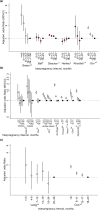Short interpregnancy intervals and adverse perinatal outcomes in high-resource settings: An updated systematic review
- PMID: 30353935
- PMCID: PMC7379643
- DOI: 10.1111/ppe.12503
Short interpregnancy intervals and adverse perinatal outcomes in high-resource settings: An updated systematic review
Abstract
Background: This systematic review summarises association between short interpregnancy intervals and adverse perinatal health outcomes in high-resource settings to inform recommendations for healthy birth spacing for the United States.
Methods: Five databases and a previous systematic review were searched for relevant articles published between 1966 and 1 May 2017. We included studies meeting the following criteria: (a) reporting of perinatal health outcomes after a short interpregnancy interval since last livebirth; (b) conducted within a high-resource setting; and (c) estimates were adjusted for maternal age and at least one socio-economic factor.
Results: Nine good-quality and 18 fair-quality studies were identified. Interpregnancy intervals <6 months were associated with a clinically and statistically significant increased risk of adverse outcomes in studies of preterm birth (eg, aOR ≥ 1.20 in 10 of 14 studies); spontaneous preterm birth (eg, aOR ≥ 1.20 in one of two studies); small-for-gestational age (eg, aOR ≥ 1.20 in 5 of 11 studies); and infant mortality (eg, aOR ≥ 1.20 in four of four studies), while four studies of perinatal death showed no association. Interpregnancy intervals of 6-11 and 12-17 months generally had smaller point estimates and confidence intervals that included the null. Most studies were population-based and few included adjustment for detailed measures of key confounders.
Conclusions: In high-resource settings, there is some evidence showing interpregnancy intervals <6 months since last livebirth are associated with increased risks for preterm birth, small-for-gestational age and infant death; however, results were inconsistent. Additional research controlling for confounding would further inform recommendations for healthy birth spacing for the United States.
Keywords: birth spacing; birth-to-conception interval; interpregnancy interval; perinatal; preterm; review.
© 2018 The Authors. Paediatric and Perinatal Epidemiology Published by John Wiley & Sons Ltd.
Figures




References
-
- Conde‐Agudelo A, Rosas‐Bermudez A, Castano F, Norton MH. Effects of birth spacing on maternal, perinatal, infant, and child health: a systematic review of causal mechanisms. Stud Fam Plann. 2012;43:93‐114. - PubMed
-
- Conde‐Agudelo A, Rosas‐Bermudez A, Kafury‐Goeta AC. Birth spacing and risk of adverse perinatal outcomes: a meta‐analysis. J Am Med Assoc. 2006;295:1809‐1823. - PubMed
-
- World Health Organization . Report of a WHO Technical Consultation on Birth Spacing: Geneva, Switzerland, 13–15 June 2005. Department of Reproductive Health and Research (RHR). Geneva, Switzerland: World Health Organization; 2006. http://apps.who.int/iris/bitstream/10665/69855/1/WHO_RHR_07.1_eng.pdf. Accessed March 15, 2018.
-
- World Health Organization . World Health Assembly, 65. Nutrition of women in the preconception period, during pregnancy and the breastfeeding period. Report by the Secretariat. Geneva, Switzerland: World Health Organization; 2012. http://apps.who.int/gb/ebwha/pdf_files/EB130/B130_11-en.pdf. Accessed March 15, 2018.
-
- Total Fertility Rate. The World Factbook. Washington, DC: The Central Intelligence Agency, Office of Public Affairs; 2017. https://www.cia.gov/library/publications/the-world-factbook/rankorder/21.... Accessed March 15, 2018.
Publication types
MeSH terms
Grants and funding
LinkOut - more resources
Full Text Sources

